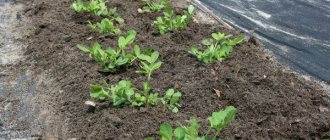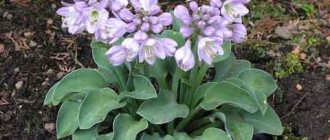Grow blueberries from seeds at home
Growing blueberries from seeds has recently become an increasingly popular practice among gardeners who want to see homemade delicious berries on their table. If you follow the rules for growing this berry, you can enjoy its great taste while harvesting a generous annual harvest.
Preparing blueberry seeds for planting. Stratification
Before planting, blueberry seeds need stratification, that is, recreating the natural wintering conditions of the seeds. This ensures their high germination rate and better growth in the future. For stratification, blueberry seeds should be placed in a container with soil in late autumn and taken to a cool basement for the whole winter, and in the city the container with seeds can be stored in the refrigerator, in the tray in which vegetables are usually placed. You can also plant the seeds directly on the site, first filling it with suitable soil.
You need to take special care of its quality. Under natural conditions, blueberries grow on fairly acidic soils, and the gardener’s task is to recreate the natural growing conditions of the berry as accurately as possible.
Emergence and care of developing plants
If the conditions for stratification and preparation of suitable soil were met, and the seeds themselves were viable, the appearance of the first shoots should be expected approximately a month after the temperature becomes high enough for this. To protect the seeds and control humidity and temperature, blueberry crops in the spring should be covered with film, glass or plastic.
Mulching plays an important role in ensuring the normal development of plants. As mulch, it is best to use the same materials that were added to the soil to acidify it, that is, pine needles, foliage and moss. With mulching you can achieve:
- optimal level of soil moisture;
- preventing it from excessive drying out;
- mulch, gradually decomposing, evenly saturates the soil with useful substances and allows you to recreate the natural conditions in which wild blueberries grow.
First wintering of young blueberry seedlings
You need to be prepared for the fact that blueberries grow very slowly, and by autumn the seedlings will only be a couple of centimeters high. In the fall, they need to be identified to a permanent place of growth. To do this, the selected area is filled with specially prepared soil and the seedlings are carefully planted so as not to damage the root system of the plant. Before the onset of cold weather, it is imperative to cover the blueberry plantation with soft spruce branches, a layer of which will not only protect the plants from the cold, but will also prevent the soil from losing a lot of moisture in conditions of little snow in the winter.
In the second and subsequent years of plant life, you need to regularly water them and update the layer of mulch, remove weeds, and apply fertilizers. The appearance of the first berries occurs 5-6 years after sowing blueberry seeds.
Substrate preparation and sowing
Blueberries are sensitive to light, so seeds are sown at home no earlier than March. If necessary, organize artificial lighting. In such conditions, the seeds quickly germinate and actively develop. Careful soil preparation guarantees seed germination and their successful transformation into a healthy plant.
Blueberries need acidic soil with a pH between 3.5 and 5.5. Soil with low acidity levels requires acidification.
For planting, prepare a soil mixture consisting of peat and pine litter. They are taken in equal proportions. A small amount of humus and sand will improve the soil structure and promote the growth of healthy plants.
An excellent option for fruitfully growing blueberries are ready-made soils for azaleas with medium acidity.
Seeds are sown in pre-prepared pots or boxes, thoroughly watered and covered with film until germination.
How to grow blueberries from seeds at home, planting and care rules
Blueberries are a wild berry rich in vitamins and microelements, especially good for vision.
Excellent taste with low calorie content has become a godsend for nutritionists; blueberry jam, muffins and rolls with blueberries are loved by sweet tooths all over the world. The berry has also been used in folk medicine for a long time.
Information on how to grow blueberries from seeds at a summer cottage will certainly be useful to beginning gardeners.
Watering, weeding, mulching
The soil under blueberry bushes should be slightly moist; excess moisture leads to diseases and death of the plant.
Plantings are periodically weeded, the soil under the bushes is mulched with sawdust or pine needles
Bushes should be weeded carefully; blueberry roots are located close to the soil surface and can be easily damaged when loosening the soil or removing weeds
Fertilizer application
If the soil acidity is low, it is necessary to add citric or acetic acid to the soil. The plant needs mineral fertilizers. Azophoska and complex potassium-phosphorus compounds are used.
Fertilizers are applied for the first time in early spring, then at the end of May, and for the last time in the first ten days of July. Once every 3-4 years, plants can be fed with compost or peat chips.
When a plant suffers from a lack of fertilizers, the yield decreases, the berries and leaves become smaller.
Bush pruning
Sanitary pruning of bushes is carried out from 3-4 years. Remove damaged, dried branches, get rid of side shoots.
Ripe berries can be stored fresh or frozen for a long time, preserving the taste and nutrients in which they are rich. Garden blueberries are completely identical to forest blueberries in their properties, so more and more gardeners are trying to grow them in their own summer cottage.
Advantages and disadvantages of growing from seeds
Garden blueberries are easy to grow from seeds; you can even use frozen berries. Of course, this is a complicated matter, but fruit-bearing bushes will certainly delight gardeners.
Planting blueberries with seeds has a number of advantages:
- you can use the seeds of frozen blueberries purchased at the supermarket;
- American varieties of tall blueberries, the seeds of which can be purchased from us, practically do not get sick and are not attacked by pests;
- garden varieties grown from seeds give a good harvest and do not differ in chemical composition from their “wild” relatives.
The disadvantages of such reproduction are:
- if the seeds are taken from a wild berry, they will not take root in the garden plot;
- even with good care, the seeds do not germinate quickly and grow slowly;
- planted in open ground in the second year after germination.
For good growth, the bushes need light acidic soil, this is a prerequisite, otherwise the plantings will not take root.
Choosing a blueberry variety
Depending on the size, garden blueberry varieties are divided into:
- short;
- medium height;
- tall.
These are frost-resistant plants with excellent taste of berries. The assortment of garden blueberries on the market allows you to choose varieties that are suitable in height and have the necessary characteristics.
When growing in pots, you should give preference to low-growing varieties, and for planting use large containers of at least 60 cm in diameter.
Pests and diseases
If the rules of planting and care are not followed, a blueberry tree may suffer from pests and diseases, despite its high natural immunity.
Main warning symptoms:
- causeless leaf fall;
- drying of branches, flower stalks;
- slow development of fruits and young shoots.
If these signs are detected, you need to carefully remove all damaged areas of the blueberry bush and treat with Topsin or Fundazol. As a disease prevention, it is recommended to spray the root area with Bordeaux mixture twice a season.
Bush blueberries can be affected by aphids and scale insects. To control pests, it is recommended to treat with Actellik or Inta-Vir.
Getting and planting blueberry seeds
Garden blueberries can also be propagated by seeds. But you should be patient, as this method is long and labor-intensive.
Important! A blueberry tree obtained from seeds does not retain its species properties, so young seedlings can differ radically from each other. To obtain planting material, you need to collect the berries after they are fully ripe.
Then mash the fruits, separate the seeds and add water. For planting, you can use only those specimens that have settled to the bottom. After this, the seeds should be dried and stored in a paper bag.
To obtain planting material, you need to collect the berries after they are fully ripe. Then mash the fruits, separate the seeds and add water. For planting, you can use only those specimens that have settled to the bottom. After this, the seeds should be dried and stored in a paper bag.
In January, planting material for garden blueberries should be placed in the vegetable section of the refrigerator for stratification for three months. This will activate growth processes and soften the outer shell.
After emergence of seedlings, the temperature should be reduced to 15°C to prevent the seedlings from stretching. Also, blueberry seedlings need to be hardened off every day by removing the protective cover. Initially, they should be opened for 15 minutes, and with each subsequent day, increase this interval by half an hour. After a week, the plants can be fully opened.
In the future, the seedlings need to be moistened regularly as needed. As the seedlings grow, they should be transplanted into separate containers. Young blueberries can be planted in a permanent place after two years.
Planting blueberries with seeds has a number of advantages:
- you can use the seeds of frozen blueberries purchased at the supermarket;
- American varieties of tall blueberries, the seeds of which can be purchased from us, practically do not get sick and are not attacked by pests;
- garden varieties grown from seeds give a good harvest and do not differ in chemical composition from their “wild” relatives.
The disadvantages of such reproduction are:
- if the seeds are taken from a wild berry, they will not take root in the garden plot;
- even with good care, the seeds do not germinate quickly and grow slowly;
- planted in open ground in the second year after germination.
For good growth, the bushes need light acidic soil, this is a prerequisite, otherwise the plantings will not take root.
If you select the seeds for sowing yourself, it is better to take the largest frozen blueberries purchased in the supermarket. Freezing is essentially stratification for seeds.
Seeds purchased from trusted sellers are fully prepared for sowing. The berries should be mashed well and filled with water. The best seeds, which are the heaviest, will settle to the bottom. The water needs to be drained several times to get rid of the berry pulp.
The seeds can be spread out on filter paper to dry, and then the required amount of planting material can be torn off and placed in the ground along with the paper. They are very small; If you don’t want to use paper, you can use a toothpick for planting.
The second way to plant a plant on a site with seeds: several fresh blueberries are buried in a selected place in the garden.
In this case, it is difficult to expect the appearance of strong, friendly shoots next year, but since the method is very simple, it makes sense to try, especially since blueberry bushes are a decoration of the landscape.
If you cannot prepare the soil yourself, you can use ready-made soil for azaleas; it is acidic and suitable for blueberries. The container with the seeds is covered with a film, which is periodically removed to ventilate the seedlings, and the soil is moistened with a spray bottle.
Landing dates
Blueberry seeds are planted in a pot in the fall. After germination, the container with the plant is taken out to a bright and cool room (an enclosed veranda or summer kitchen is suitable) with a temperature of +5-8 °C. In the spring, the pots with the plant are taken out into the air, and a homemade blueberry bush is planted in open ground with the onset of autumn or next spring.
Important: blueberries grow extremely slowly; The first year after planting, the plant must be covered for the winter with sawdust, spruce branches or special fabric.
It begins to bear fruit in the 3rd year and produces good harvests for 20-30 years.
The best times and methods for planting blueberry bushes
Blueberries are usually planted in autumn or spring. The most favorable time is the end of October and the beginning of November.
It is necessary to plant 2-3 year old plants with a native clod of soil. It is necessary to moisten the soil on the roots generously with water. If you ignore this requirement, the bushes most likely will not take root and will quickly die.
The root ball must be loosened before the bush is placed in the ground. In addition, the roots should be straightened. After which they are covered with earth and then everything is compacted. We water the planted bush with water, which will need a lot, but only so as not to completely flood the root system.
If possible, the area with seedlings should be mulched, that is, materials suitable for delaying moisture evaporation should be placed around the bushes. This could be sawdust, fresh peat, or large fallen leaves such as oak or maple.
When planting older bushes that are more than 4 years old, the branches should be trimmed, but this should be done no more than 20 centimeters.
All these procedures will enable blueberries to feel good and bear fruit in a new place.
When planting older bushes that are more than 4 years old, branches should be trimmed
Blueberries: planting, growing and care
Blueberry is a low and highly branched berry shrub from the heather family. It easily and unpretentiously tolerates winter frosts; blueberries can also be found in the Arctic Circle. In the wild it grows in mixed or coniferous forests, most often in the latter. Some pine forests are so overgrown with blueberry bushes that they are called blueberry pine forests.
In general, such a neighborhood is not accidental. Like pine, blueberries do best in acidic soils with close groundwater. It is also a shade-loving shrub, so it should be planted under the canopy of trees that can provide constant partial shade under them.
Planting blueberries
Before planting blueberries, you need to prepare in advance the area where they will grow in the future. Typically, garden soil is not acidic enough, so planting blueberry bushes prematurely in unprepared soil can lead to yellowing of the leaves, stunted development, and even death of the plant. For successful cultivation, pits measuring 150x150 cm and 60 cm deep each are prepared for each bush. The dug soil from the holes is mixed with peat chips (in a ratio of 2:1), to further acidify the soil, add powdered sulfur. Also, if possible, you can add kitchen peelings and oak leaves, and river sand in heavy soils. Such preparation is carried out in advance, the main thing is that the prepared soil settles in the pits before planting. For example, if you planned to plant blueberry bushes in October, the soil should be prepared no later than September.
Blueberries are planted in spring or autumn; bushes planted in the autumn, from October to early November, take root best. The best option for planting would be two- or three-year-old bushes with a lump of earth on the roots. The root ball must be moist before planting: bushes planted with dry roots in most cases do not take root and die. Before planting, in the previously prepared soil, we dig a hole the size of the root ball, where we plant the bush. During planting, loosen the soil on the root ball and carefully straighten the roots. Then we fill the hole, compact the soil around the planted bush with our feet and water it abundantly. If possible, mulch the ground at the planting site; you can use fallen leaves, sawdust or peat as mulch. If you are replanting old bushes (more than 3 years old), after planting you need to trim the branches to a height of 20 cm - this will help the bush to take root better in its new location.
Blueberry propagation
Blueberries are propagated by seeds or by dividing the bush.
Propagation of blueberries by seeds
First you need to get blueberry seeds. To do this, mash the ripe berries and mix the resulting pulp with plenty of water. After mixing, empty seeds and remaining berries float to the surface, which we drain together with water. We do this until the water becomes clear. As a result, at the bottom of the vessel we will have seeds suitable for planting. After drying them a little before, we plant them in pots or boxes filled with peat. The seedlings will emerge in a few weeks. For the winter, it is better to move containers with seedlings to a bright room where the temperature is maintained at 5-10 ºС. In the spring, blueberry seedlings are picked and then grown. Seedlings are planted in a permanent place only the next year.
Is it possible to grow blueberries in your dacha?
It was believed that growing blueberry bushes in the garden would not bring a large harvest of berries. But the culture is becoming increasingly popular among gardeners. More agrotechnical measures are appearing that make it possible to grow berries even in the country.
Blueberries are accustomed to coniferous forests, with damp soil and little light. Therefore, you will have to provide similar conditions in your garden.
Blueberries have a branching root system, which causes many shoots to appear. The leaves are small, with serrated edges, shiny, densely covering the entire bush.
Begins to bloom in mid-May. Pollination occurs due to bees and bumblebees. Having an apiary next to blueberry bushes, the honey will be fragrant, transparent, and reddish in color.
In nature, the plant is often found in the European part, North America and Asia.
Blueberry growing technology
Young wild blueberry bushes are great for planting. They can be planted in a row of several bushes or separately from each other.
Prepare the soil before planting. To do this, it must be cleared of weeds and loosened. Then a shallow trench is dug into which forest litter and organic fertilizers are placed. Sand is poured on top of the fertilizer to create conditions that are as close to forest conditions as possible. To prevent the spread of infection and the proliferation of parasites, the sand is sprinkled with sulfur. In order not to harm the acidity of the soil, it is not recommended to use wood ash.
If the soil on the plot of land has neutral acidity, then it needs to be watered with a solution of citric acid. A bucket of water will require 1 tbsp. acids. Improve the acid characteristics of the soil by adding chopped pine branches. If you read the article - Growing fir in a summer cottage, and put it into practice, then there will be no problems with the branches.
Shredded pine branches will help make the soil for blueberries more suitable for growing
The most optimal time for planting Blueberries is autumn or spring; there is no special time frame. To propagate shrubs, you can use seeds, shoots and other vegetative parts of the plant. Regardless of the choice of propagation type, Blueberries can grow for many kilometers.
During the first week of cultivation, the shrub should be watered abundantly, after which watering should be gradually reduced until it stops completely. When Blueberries have adapted well to new conditions, they need to be watered only in times of severe drought, when the soil dries out. To ensure that the soil retains moisture for a long time, it is covered with mulch.
Fertilize the bushes with a small amount of mineral fertilizers without adding organic matter, which it does not tolerate well. The plant should be fertilized in July and September. The shrub receives all the necessary useful elements from the soil using the root system.
Propagation using seeds
Blueberry berries are suitable for propagation. They are first stored in the freezer for a long time. Low temperatures prepare the seeds inside the fruit for better germination. It is best to propagate Blueberries using seeds in microgreenhouses.
After the seeds have been prepared, they need to be separated from the berries and planted in a container with soil under a film. To create optimal conditions, containers are placed under fluorescent lamps. The soil in the container should be periodically ventilated and watered. After three weeks, the seeds produce their first shoots. After this, the film must be removed from the container.
When four leaves appear, the seedlings are transplanted into a greenhouse. If the seeds were sown in the spring, then in August the film is removed from the beds. Before frost, the ground is mulched.
After the plants have overwintered, plant them directly in the garden bed.
Common blueberry. Growing according to all the rules
1. Trimming.
In order for the black berry in the garden to grow correctly, evenly and produce good fruits, it must be constantly looked after. To begin with, it should be trimmed, that is, excess shoots should be trimmed. This plant is suitable for three to four years. All diseased, damaged and dried branches should be removed. The cutting height is 20 centimeters. The ideal option is when there are from 5 to 9 full-fledged and strong branches left on the bush. This will be the main part of the entire bush. If the plant produces many young shoots on which buds develop, they still need to be removed. It will not be possible to harvest normally from such branches. The berries will be too small and sparse. Old bushes that are already 15 years old or more should be heavily pruned. The height of the left stem is about 20 centimeters. Thus, the bush rejuvenates and continues to bear fruit at the same level.
Spring is the most favorable period for pruning and shaping bushes. The main thing is that after this procedure there is no frost. Avoid pruning branches too late, especially when flowering begins. This will lead to a decrease in yield.
Spring is the most favorable period for pruning and shaping bushes.
2. Watering. Shrubs should be watered regularly
But it's important not to overdo it. The soil under the bush should always be slightly moist
You can use mulch for this. If the blueberries are in an open area, on hot days it is necessary to spray them, or arrange small ponds next to the plants, placing buckets, basins and other containers with water. If the soil is not acidified enough, water it with slightly acidified water (1 teaspoon of citric acid per bucket of water).
3
Fertilizing is an important condition for successful blueberry growing and good fruiting. It is worth noting that the plant will not tolerate actively decomposing organic matter.
It is best to apply a full range of mineral fertilizers early in the spring or late in the fall.
Video about caring for blueberries
4. The garden blueberry harvest occurs in June and lasts until the beginning of September. The fruits will ripen unevenly throughout the bush, and you should not expect a one-time harvest. They will have to be collected every 5-10 days. Berries suitable for harvesting have a blue-violet tint or black color. In order not to damage the berry during picking, it is necessary not to pick it, but to turn it. At zero temperatures, the harvested crop can be stored for up to 6 weeks.
Common blueberries are not divided into varieties. But myths about it are created by the engine of trade - advertising. After all, many people want to have this plant on their plot, so they buy seedlings of the so-called garden blueberries at the markets, the cultivation of which has its own subtleties. You should carefully consider the choice of such planting material, because often instead of common blueberries you are offered varietal blueberries similar to them. To avoid falling for a fake, grow the planting material yourself. Although this is a troublesome, but profitable and exciting activity!
Will a bush grown from a seed bear fruit?
During seed propagation, the properties of mother plants, as a rule, are not transmitted. Therefore, it is impossible to predict what the fruiting of an adult plant will be like. Some bushes can bear large berries and produce large yields. Other bushes under the same growing conditions often produce small berries in small volumes. To achieve good harvests, choose the healthiest and most fruit-bearing plants and propagate them by cuttings or dividing an overgrown bush.
Preparing soil that is suitable for all parameters, using high-quality seed material and paying close attention to growing plants allows you to grow garden blueberries at home and enjoy their healthy berries.
When can we expect the harvest?
Young blueberry bushes will not begin to bear fruit very soon. If the plant is obtained from a seed, then you will have to wait 5-6 years for berries. In the case of blueberry propagation by cuttings, it is somewhat faster.
In any case, if you grow the seedlings yourself, choose a location and properly prepare the acidic soil, your efforts will be fully rewarded. And a personal blueberry plantation will annually provide you with tasty and healthy berries, and, of course, will become a reason for pride.
Landing instructions
Sowing seeds and growing seedlings is not difficult at home. The main thing is to create the necessary soil and moisture conditions, follow the recommendations of specialists on planting and care.
Seed preparation
Before planting in the spring, blueberry seeds must undergo a stratification process, which imitates the natural overwintering of seeds in nature . The procedure significantly increases the germination of planting material and better development of the plant in the future. To do this, the seeds are placed in a container with soil at the end of autumn and transferred to a cool place (basement, refrigerator shelf).
How to properly grow blueberries from seeds?
Blueberries are not just tasty, but also very healthy berries, rich in vitamins and minerals beneficial to human health.
Blueberries usually grow in acidic soils, in coniferous forests, and prefer shade and relative coolness.
By creating optimal conditions for blueberry growth, you can enjoy this aromatic and juicy berry grown in your own garden. This is not at all difficult to do; the main thing is to plant the shrub correctly and care for it.
Blueberry belongs to the heather family and is a low shrub with a large number of shoots. The maximum height of a blueberry bush is 70-80cm.
Ripe berries have a beautiful dark blue, almost black color, the flesh is dark purple with many small grains of seeds, which are almost not felt when eating the berries.
A shaded area is more suitable for growing blueberries, for example, under a tree or in the shade of a fence or some structure on a personal plot.
How do blueberries reproduce?
- Cuttings.
- Dividing one bush into several parts.
- Sowing seeds.
Cuttings
Propagation by cuttings is easy, so even an inexperienced gardener can cope with this task. In the summer, cuttings 5-7 cm long are cut from the main bush, after which they are planted in a greenhouse for rooting. After strong roots appear, the plant is planted in the ground.
Dividing the bush into several parts
An equally simple way to propagate blueberries. In the fall, dig up a large overgrown bush and then carefully divide it into parts without damaging the roots.
In this case, you should pay attention to ensure that each individual bush has 4-5 intact buds.
Collecting and planting seeds
A popular way to propagate blueberries is by planting seeds. Seeds can be collected not only from ripe berries, but even from frozen ones. In addition, in any specialized store you can inexpensively purchase ready-made planting material.
Wild and garden blueberries
Wild blueberries are different from garden blueberries. Its taste and aroma are richer and brighter, but the berries are smaller in size. The garden blueberry bush is taller than wild blueberries can grow. Sometimes such bushes reach a height of one and a half meters.
Propagation of blueberries by seeds from berries
To obtain seeds from a ripe berry, you need to crush it in some small container and fill it with cold water to separate the pulp from the seeds.
After the seeds float to the surface, carefully drain the liquid along with the remaining berries. Repeat this manipulation several times, the water will not be clean.
Remove the seeds using a strainer, place on paper and leave to dry completely.
Plant the seeds together with paper in a pot filled with peat.
After a couple of weeks, the first small shoots will appear. During cold weather, pots with blueberry sprouts should be moved to a warm room where the temperature does not drop below 10 degrees Celsius. And in the spring, pick and grow seedlings. As soon as weather conditions become favorable, plant blueberries in the ground in previously prepared areas.
Some gardeners use a simpler and less labor-intensive method of propagating blueberries - they simply bury ripe blueberries in the ground before winter. And in the spring they are waiting for shoots. This method is ineffective, since the formation of new plants is influenced by various negative factors, for example, weather conditions, soil composition, etc., and the process can take up to three or more years.
How to grow blueberries correctly
Basic rules and tips:
- For better development of the root system, plants should be planted at a distance of at least one meter from each other.
- Fertilizers should be applied to the soil in March or November.
- Weed removal should be carried out regularly, at least once a week.
- In order for the plant to take root, it should be watered twice a week, one bucket per bush.
- Dried and diseased branches should be removed in the spring.
- If there is water on the site for a very long time after rain, or the soil is too wet, it is better to completely abandon the idea of growing blueberries.
Every three years, blueberries need to be fed with mineral fertilizers. Birds love to eat blueberries. To prevent birds from pecking at blueberries, you can hang New Year’s “rain” around the bushes, this will scare away the birds, and the harvest will remain intact.
Blueberry propagation methods
Blueberry is a shrub that produces long shoots and grows up to eighty meters high. The shrub belongs to the Heather family. The berries are black with a purple tint and contain many seeds inside. In order to plant blueberries on your site, it is necessary, first of all, to choose the right soil and place for planting. It should be taken into account that the soil must have high acidity. In addition, the plant needs to be grown in places where there is constant shade. This could be fences or shade from large trees with a dense spreading crown.
The shrub reproduces in three ways:
In order to plant blueberries using cuttings, they must first be prepared correctly. To do this, cuttings of at least six centimeters in length are cut. They are buried in a greenhouse or box in order for a root system to form. Only after this, young blueberry bushes are planted in open soil. This method of propagation is suitable only for the summer period. In order to plant blueberries from cuttings, you need to select only woody shoots.
The cut of the cutting must be straight. To reduce moisture evaporation, the lower leaves are completely removed and the upper leaves are shortened. The lower edge of the cutting must be treated with a root formation stimulator.
A layer of peat or peat humus is poured into the box. The ball must be at least six to eight centimeters. River sand is poured on top, in a layer of two to three centimeters. The cuttings are planted in sand, but in such a way that they do not come into contact with peat. Otherwise, the peat layer may cause rotting of the cuttings.
The box is covered with film or glass. During the formation of the root system, it is necessary to monitor the condition of the soil. It must be constantly wet. To do this, spraying is carried out periodically. In addition, young seedlings need ventilation.
Seedlings grown from cuttings do not need to be disturbed until spring. In winter, they are covered with spruce branches and only after the snow has melted and it becomes warm, can the strongest plants be transplanted to a permanent place.
Shrubs are propagated by cuttings
In autumn, blueberries can be propagated by dividing the bush. In this case, the mother bush is dug out of the ground and divided into several bushes. But at the same time, it is necessary to ensure that the kidneys are not damaged during division.
The most popular method of propagation still remains the seed method. But at the same time, you can use the seeds from both fresh ripe blueberries and frozen ones. In addition, you can purchase ready-made seed material at a seed store.
When planting blueberries on your site, you need to be able to determine where the wild blueberries are and where the garden ones are. Garden blueberry bushes grow to a height of at least one and a half meters, and the berries do not have a bitter taste, although the aroma is weak compared to wild ones.
We prepare the soil in September, plant in October
Before you start growing blueberries at home, you need to prepare the area well. Many people mistakenly believe that this plant should be planted in the shade under trees. This is a mistake. Only sufficient lighting will allow you to get a good harvest of berries. Partial shading, clearings between trees and near a pond are suitable.
Only sufficient lighting will allow you to get a good harvest of berries.
The main requirement is constant moderate soil and air humidity.
- The soil in the country, as a rule, has weak acidity. In order for blueberries to grow and bear fruit well, this must be corrected. If we are talking about bush planting, then a hole is dug under each bush, measuring 150 by 150 cm and 60 cm deep.
- Peat crumbs are added to the excavated soil in a ratio of 2:1.
- True, natural acidity will not be enough, so it is necessary to add powdered sulfur. In this case, oak foliage and, of course, pine needles would be a good feed.
- When the soil is quite heavy, for example, clayey, then it would be useful to add sand. River water is best suited for these purposes.
It should be remembered that all these activities should be carried out in advance. Before landing, all actions will be in vain. All additives must settle in the ground. If planting is planned for October, then September will be the main month for soil preparation.
If planting is planned for October, then September will be the main month for soil preparation
How to plant blueberries
Planting blueberries is quite simple, but requires compliance with some rules. How well the bush will take root depends on how responsibly you take the choice of soil and, in fact, the planting material itself.
Choosing the right pot
The first step is to prepare the pots
It is important to pay attention to the size of the container: its diameter should be between 50–60 cm and its depth about 40 cm. Be sure to make sure that there are drainage holes in the bottom of the pot through which excess water will come out. If blueberry roots remain in stagnant water, the process of rotting will begin, as a result of which the crop may die
If blueberry roots remain in stagnant water, the process of rotting will begin, as a result of which the crop may die.
Regular garden soil is not suitable for growing blueberries on a windowsill. It is best to purchase a ready-made mixture - heather compost, which is an acid-alkaline mixture. You can buy soil that is sold for azaleas, camellias or rhododendrons. This mixture needs to fill the pot to 2/3 of its height. A layer of compost should be placed on top.
It is advisable not to be lazy, go to the forest and collect pine bark, chop it up and mulch the soil. Such a cover will not only “remind” the blueberries of their natural habitat, which is the forest, but will also help preserve soil moisture.
Did you know? Seeds do not necessarily have to be obtained from varietal berries
—
they can even be “obtained” from wild blueberries, but seedlings dug up in the forest do not take root at home.
Preparation of planting material
In nurseries and gardening centers, seedlings are sold with a closed root system, most often in containers. Before planting, you need to carefully remove the bush from the container and dip the rhizome along with the soil in water - only after that you can start planting.
It is also possible to treat seedlings with rooting agents, such as “Rhizopon”. The product has a powdery consistency. There is no need to wet the roots before treating the seedling in it.
Planting process
To grow blueberries at home, you can purchase ready-made seedlings or grow them yourself from seed. The first option is more acceptable, as it will significantly bring the time of harvesting the first harvest closer. Sowing seeds is a long and painstaking process, but quite interesting; in addition, it allows you to obtain a larger amount of planting material at one time.
Sapling
When the seedling is already at home and the pot is ready, you can begin planting, which should proceed as follows:
- Place a drainage layer of pebbles at the bottom of the container.
- Fill the pot with the mixture as described earlier in “Choosing a suitable pot.”
- Form a planting hole, which should be slightly larger than the rhizome of the seedling with an earthen lump.
- Place the seedling in the hole and fill it up.
- Dilute ½ tsp in 1.5 liters of water. citric or oxalic acid and water the planting.
- Mulch the top with pine bark and compost.
Semenya
To plant seeds, they must first be extracted from the berries. This is done very simply: several fruits need to be placed in a glass, crushed well and filled with water. You can mash the berries a little more with your fingers in the water. After this procedure, the seeds will sink to the bottom of the glass, and the remains of the berries will remain on the surface. Next, you need to carefully drain the water and remove the seed.
Next you need to follow this algorithm:
- Place the seeds in water for a day to swell.
- Prepare a container for planting. Make sure it has holes to drain excess moisture.
- Fill the container with peat.
- Immediately before planting, treat the seeds in a weak solution of potassium permanganate for 30–40 minutes - this will protect the material from disease.
- Plant the seeds in the ground to a depth of 1 cm. The distance between them should be about 2 cm.
- Water the soil with a small amount of acidified water (1 teaspoon of citric acid per 3 liters of water).
- Cover the planting with film or glass and place in a warm place.
The seed germination process can take several weeks. During this entire time, you need to lift the cover daily, ventilate the “greenhouse” and water the soil so that it remains moist. After the first shoots appear, the film is removed completely.
The soil should be watered abundantly, compacted and sprinkled with a layer of sawdust mulch. The container with the planting should be kept in a warm room all winter. Watering can be reduced to several times a week. In spring, already grown seedlings can be planted in separate pots.
Garden blueberries: propagation from seeds of ripe berries
In order to collect blueberry seeds at home, you need to mash several berries in a glass and add plenty of water. Since a blueberry seed is still heavier than water, the seeds will settle to the bottom, and the peel and pulp will float to the surface. The water must be carefully drained. The procedure is carried out several times in a row until the water becomes completely clear. The seeds are taken out of the glass, laid out on a napkin and dried. After this, you need to fill the pots, boxes or other containers with peat and sow the seed in a thin layer.
Caring for a plant on the windowsill
To see their plant healthy and enjoy delicious fruits, owners need to know the basic rules of care and not neglect them. Be sure to familiarize yourself with when to water the crop, what to feed it, and how to ensure pollination - these factors will determine whether you will be able to harvest a good harvest.
Watering
Plants living in containers require much more watering than those growing in the garden. You need to check the soil daily - it should be moderately moist. Do not allow the soil to be wet.
To check, lower your finger into the ground at the level of the phalanx. Blueberries are watered once a day, and in hot weather you can increase the number of waterings to 2 times a day. The amount of moisture is determined by eye - water is poured slowly until it begins to seep through the drainage holes.
Important! If you plant blueberries in a clay pot, the soil will dry out faster than in a ceramic or plastic one due to the clay’s ability to “breathe.”
Fertilizer
When choosing complex fertilizers, give preference to those designed for acid-loving plants. For example, the mineral composition “Biohyper Extra” would be a good option. It is designed both for soil fertilization and as foliar feeding, increases immunity and productivity of blueberries, and ensures simultaneous ripening of berries. As a result of its use, the shelf life of the harvest increases.
No less effective is the complex mineral composition “Agrecol for blueberries”. Granular fertilizer contains the optimal amount of nutrients necessary for normal crop development and good fruiting.
Fertilizing is applied 2 times in the spring - in March and May. During these periods, fertilizers are needed to stimulate good crop growth and berry set. There is no need to feed blueberries for the rest of the period.
Lighting
Blueberries, like all fruit-bearing plants, love good lighting, in which the berries form faster and become more juicy. The pot of blueberries should be placed on the windowsill near the window so that the plant is exposed to the sun for at least 6-8 hours a day. If your windows get very little sunlight, you will need to equip them with additional lighting using phytolamps.
Important! Blueberries love the change of seasons, so in winter the pots should be moved to a cooler, dimly lit room and watered very rarely, just so that the bushes do not dry out completely
How to ensure pollination
In nature, pollination of blueberries occurs with the help of pollinating insects: bees, bumblebees, etc. In an apartment, of course, this method is not permissible, so you need to know how you can carry out pollination yourself.
To do this, during the flowering period, you need to take an ordinary brush and walk it over each flower. This way the pollen will be transferred from bud to bud. It is advisable to perform this procedure several times throughout the flowering period.Care after transplant
Blueberries are demanding on growing conditions. It needs regular moisture, acidic, nutritious soil and mulching is recommended. Blueberry bushes require annual sanitary pruning.
Important! After planting seeds, the first harvest can be obtained only 5 years after the sprouts appear
Watering
The root system of blueberries is close to the surface of the earth. It needs to be watered moderately and ensure that the soil does not dry out or become excessively waterlogged or stagnant. When watering, soil erosion should not be allowed. This berry crop loves sprinkling in hot weather. If the soil is not acidic enough, add a small amount of citric acid to the water for irrigation.
Fertilizer application
Blueberries bear fruit well if they have enough nutrients. Therefore, the plant is fed with both mineral fertilizers and organic matter. Young plants are not fertilized. The need for them appears after 2 years of fruiting, that is, from the 7th year of life. Add complex mineral fertilizers for heathers and well-rotted organic matter (humus, peat chips, chicken droppings). Organic components are added to the soil every 3-4 years, and chemical components - annually.
The first feeding is done in the spring, and the second in the summer. As a spring fertilizer, you can use Aciplex (10 g per 10 l). This feeding should be done 2 times with an interval of 10 days. In June, it is good to feed the blueberry bushes with Piafoskan (20 g per 10 l). If there is a lack of soil acidity, it is recommended to add 50 g of sulfur powder under each bush.
Growing conditions
To grow Blueberries, acidic soil on which vegetable crops have not previously grown is ideal. Also, such soils are perfect for growing Cranberries or Blueberries. Blueberries do not like direct sunlight, so places in the shade of trees, near a fence or next to buildings are great. Due to its lack of cultivation, the shrub is planted at some distance from vegetable and flower beds, otherwise you risk reducing their yield due to infection.
A rich harvest is possible only from bushes growing on acidic soils
Watering
Blueberries do not require frequent watering. In summer, watering is necessary no more than twice a month. If a hydrogel was used, less water is required. Excessive moisture provokes plant diseases, as a result of which it may die. If hydrogel has not been added to the soil, blueberries should be watered more often. The watering system should not be disturbed if the plant is young. It needs to develop a root system before winter in order to survive frosts. Poor watering can slow down root growth. An adult plant requires less abundant watering. It is enough to carry out the procedure of moistening the soil once a month. Large amounts of water should be avoided, as the soil around the bush collects moisture well.
Weeding and loosening
Weeding and loosening the soil is carried out more often than watering. These actions should be carried out immediately after grass appears around the bush. After weeding, extraneous plants must be removed from the site so that they cannot germinate again. The blueberry root system is close to the surface. In order not to damage the root, loosening is carried out to a maximum depth of 3 centimeters. Before loosening, it is recommended to pour a five-centimeter layer of sawdust onto the ground around the bush, and then carry out the procedure.
Top dressing
Plants require fertilizing for the first few days after planting. For blueberries, two types of fertilizing are used: root and foliar. Only liquid fertilizers are used, since the integrity and safety of the root system depends on this. For blueberries, it is recommended to use three types of fertilizer:
- nitrogen;
- phosphorus;
- complex of microelements.
This is interesting: Methods and step-by-step recommendations on how to prune currants in the fall
The use of fertilizers reduces the acidity of the soil, which negatively affects the plant. To avoid this, the fertilizer is mixed with a solution of colloidal sulfur. The diluted substance is watered around the bush and directly under the root. The best time to fertilize is evening. The fertilizer should be diluted in water whose temperature is warmer than the air. Foliar feeding is carried out using a sprinkler. Recommendations for diluting the substance are the same as for root feeding. Fertilizer is evenly sprayed onto the bush. It is not recommended to perform the procedure during the daytime, since the leaves can get burned when exposed to sunlight. Foliar feeding protects the plant from pests. It is recommended to fertilize twice a month after each watering. Do not apply fertilizers before watering.
We form young seedlings
Blueberries are not pruned immediately after planting. Only in the 3-4th year do they begin to carry out annual pruning. At the same time, frozen, dried and damaged branches are removed. For good fruiting, an adult plant requires 6-8 strong, developed branches. Weak and underdeveloped shoots are removed. Old branches are gradually updated with new ones.
The aging of bushes immediately affects the yield, so a plant older than 15 years needs strong anti-aging pruning. It is carried out in early spring at a temperature no higher than +5 °C at a height of about 30 centimeters above ground level. The sections are carefully treated with garden varnish.
Protection from diseases and pests
If a plant is infected with a viral disease, it is dug up and burned to protect other bushes from infection. Insecticides are used to control aphids. Bordeaux mixture applied to the bush by spraying helps against scale insects. It is recommended to use fungicides against diseases. To prevent the occurrence of diseases, fallen leaves must be collected and burned. The presence of pests can be detected in winter. In spring, a sign of their appearance is a cobweb on the plant. Blueberries are a healthy plant whose fruits contain a large amount of vitamins. Having created favorable conditions, it can be grown on your own plot of land. But for this it is necessary to adhere to a number of rules for planting and care.
Do I need to cover it for the winter?
Blueberries tolerate sub-zero temperatures well. An adult plant does not need shelter. The roots of young seedlings are protected from severe frosts with a thick layer of sawdust mulch.











